This is a sprain to your knee
Healing:
It can take 6-12 weeks for this injury to heal, depending on the severity of the injury.
Smoking will slow down your healing. We would advise that you stop smoking while your injury heals. Talk to your GP or go to www.smokefree.nhs.uk for more information.
Pain and swelling:
Your knee will be swollen and you will have some pain. Swelling is often worse at the end of the day. Taking pain medication, elevating your knee and using ice or cold packs will help. More information is in the next section.
It is normal to have mild pain and swelling for 3-6 months.
Walking and your brace:
You are allowed to put weight through your leg. You may find it easier to use crutches in the early stages. You will need to pace your activity until your pain and movement is better.
You may have been given a knee brace in A&E. This can be used to help manage your symptoms in the early stages. Try to stop using the brace as soon as you can.
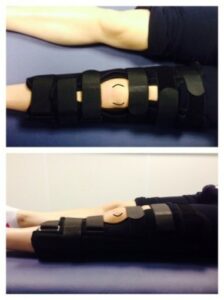
Exercises:
It is important to start exercises as soon as possible. Instructions are in the next section.
Follow up:
You will receive a face to face appointment in the Fracture Clinic 2 weeks after your injury. If you have not received your appointment letter within 1 week please contact the Fracture clinic.
Any questions:
If you are concerned about your symptoms, unable to follow this rehabilitation plan or have pain other than at your knee, please contact the Virtual Fracture Clinic team.
Caring for your injury
If provided, use your brace for comfort. This video provides you with a guide for fitting your brace. Try to stop using the brace as soon as you can. Remove your brace to wash, dress and do your exercises.
Using a cold pack will help with your pain and swelling. You can use an ice pack or bag of frozen peas wrapped in a damp towel. Put this on your knee for up to 15 minutes every few hours. Make sure the ice is not in direct contact with your skin.
Try to rest your knee, especially in the first 24-72 hours. Raise your leg on a stool or cushions to that it is above the level of your hip. This will help to reduce your swelling.
Exercises:
Early exercise is important to recover movement and promote circulation. This will reduce the risk of developing a Deep Vein Thrombosis (blood clot). If you notice any swelling or redness in the calf, please attend A&E.
Do these exercises 3-4 times a day. Start straight away, you do not need to push into pain.
Ankle Exercises
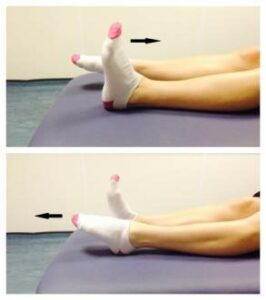
Rest with your leg supported.
Point your foot up and down. Repeat this 10 times.
Static Quadriceps Exercise
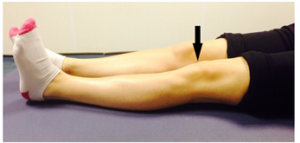
Rest with your leg supported and straight. Gently tense the muscles in your thigh and try to straighten your knee further. Hold for 5 seconds and repeat 7-10 times.
Inner Range Quads Exercise

Place a rolled up towel or small pillow under your injured knee.
Tense your thigh muscle and try to straighten your knee. Keep the back of your knee in contact with the towel/pillow.
Repeat 10 times. If you can, try to hold your knee straight for 5 seconds.
Knee Flexion and Extension
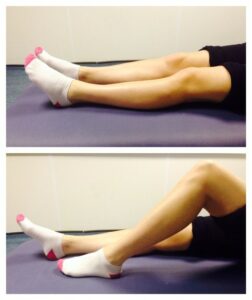
Sit or lie with your legs out stretched.
Bend and straighten your injured leg. Go as far as you feel comfortable.
Repeat 7-10 times.
Seated knee flexion and extension
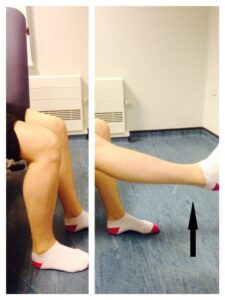
When you can do the first knee bending exercise easily, you can progress to this exercise.
Sit on a chair or on the edge of your bed. Bend and straighten your knee, lifting your heel off the floor.
Repeat this 10 times.
If you can, try holding your knee straight for 5 seconds.
Frequently Asked Questions
I am struggling with my brace. What do I do?
Please contact the Virtual Fracture Clinic.
When can I start driving?
You can return to driving when:
- You are no longer using your brace
- You can walk comfortably
- You can perform an emergency stop pain free
Always test your ability to drive in a safe environment first.
How can I get a certificate for work?
You can self-certify for the first 7 days following your injury. For any longer periods, please discuss the provision of a fitness to work statement with the Virtual Fracture Clinic Team or your GP.
What do I do with my brace and crutches when I no longer need them?
We are not able to use brace again. These should not be returned to the hospital.
Crutches can be returned to the Fracture Clinic or A&E.
Contact Details for Bedford and Luton
Please contact the hospital where you attended A&E as the other site will not be able to access your notes
BEDFORD HOSPITAL PATIENTS
How do I contact the Virtual Fracture Clinic (VFC)
- Telephone 01234 792036
- Messages will be checked every morning Monday to Friday (except for Bank Holidays)
- Email VFCBedford@bedfordhospital.nhs.uk
How do I contact the Fracture Clinic?
- Telephone 01234 792138
How do I contact the Plaster Room?
- Telephone 01234 792031
- Monday to Friday 9am to 5pm (out of hours contact the Emergency Department)
LUTON & DUNSTABLE HOSPITAL PATIENTS
How do I contact the Virtual Fracture Clinic (VFC)
- Telephone 01582 718121
- Messages will be checked every morning Monday to Friday (except for Bank Holidays)
- Email VFCLuton@ldh.nhs.uk
How do I contact the Fracture Clinic?
- Telephone 01582 497194 or 01582 718 993 (outpatient appointments)
How do I contact the Plaster Room?
- Telephone 01582 491166 (ext. 2233)
- Monday to Friday 9am to 5pm (out of hours contact the Emergency Department)
